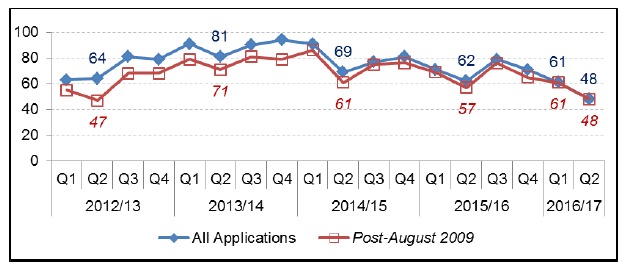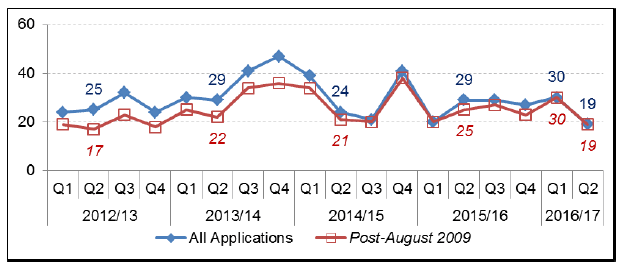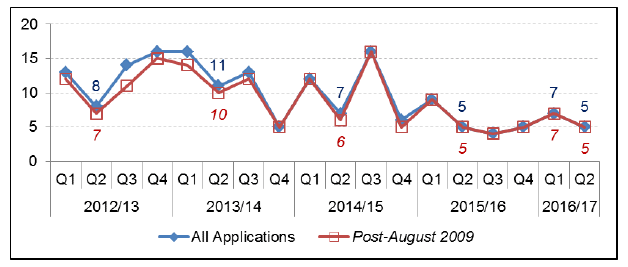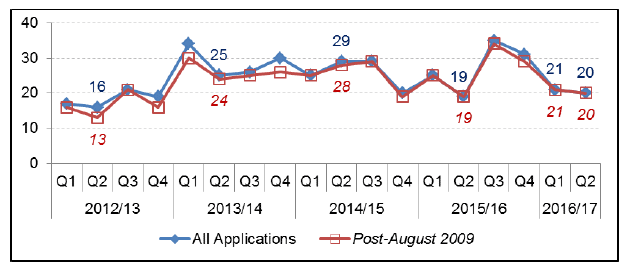Planning performance statistics: second quarter, 2016-2017
This report presents the latest summary statistics on planning decision-making and timescales for July to September 2016 (Quarter 2).
3. Major Developments
Major developments include applications for developments of 50 or more homes, as well as other applications covering areas of development such as minerals, housing, business & industry, waste management, electricity generation, freshwater fish farming, marine finfish farming, marine shellfish farming and other developments. Classification between local and major developments depends on the particular development type. For example, housing developments are classed as major when the application is for 50 or more dwellings or for a site that exceeds two hectares, whereas electricity generation is classed as major when the capacity of the generating station is or exceeds 20 megawatts.
Details for the classification of all development types can be found here: http://www.gov.scot/Resource/Doc/278390/0083657.pdf
This section presents quarterly information on average timescales across all major developments, along with separate figures for the key categories of housing, business and industry and other developments. Information on other more detailed categories of major developments is reported on an annual rather than quarterly basis.
3.1 All Major Developments
For applications subject to average time calculations there were 48 major applications decided during the second quarter of 2016/17 with an overall average decision time of 44.8 weeks, over five weeks slower than the previous quarter (39.3 weeks) and the slowest average decision time since the start of this data collection in quarter one of 2012/13. Comparable figures for quarter two in previous years were 28.1 weeks in 2015/16, 32.6 weeks in 2014/15, 34.1 weeks in 2013/14 and 35.2 weeks in 2012/13. ( Quarter 2, 2016/17 - Table 2)
Chart 23: All Major Developments: Number of decisions

Chart 24: All Major Developments: Average decision time (weeks)

It should be noted that the average time figure of 44.8 weeks has been influenced by two very lengthy decision times (3.8 years and 5.4 years). Without these two applications the average decision time would be 36.2 weeks. Almost 73% of the 48 major development applications were decided in a time that was quicker than the average. Further information on the distribution of decision times for major development applications is given in Annex A.
In addition there were a further 17 applications for major developments concluded in quarter two of 2016/17 that were subject to separate processing agreements. 100% of these applications met agreed timescales that had been set between developers and local authorities. Applications subject to processing agreements are not included in average time calculations.
The time taken to make decisions on major applications can vary greatly between planning authorities and average figures based on a small number of applications can be volatile.
In quarter two of 2016/17 Aberdeenshire made the most decisions on major developments (10 in total), three of these had an average decision time of 30.6 weeks and a further seven major applications had processing agreements with 100% meeting the agreed timescales that had been set between the developer and local authority.
3.2 Major Housing Developments
Major Housing developments are those with 50 or more dwellings or have a site area that is or exceeds 2 hectares where the prodominant use is for housing. For applications subject to average time calculations there were a total of 19 major housing developments decided during the second quarter of 2016/17 and the average decision time was 48.5 weeks, slower by one day compared to the previous quarter (48.3 weeks). Equivalent quarter two figures for earlier years are 34.4 weeks in 2015/16, 38.5 weeks in 2014/15, 42.8 weeks in 2013/14 and 34.8 weeks in 2012/13. ( Quarter 2, 2016/17 - Table 7)
Chart 25: Major Housing Developments: Number of decisions

Chart 26: Major Housing Developments: Average decision time (weeks)

Average figures based on a small number of applications can be volatile. In this quarter there were seven applications with a decision time of more than one year. 58% of the 19 major housing development applications were decided in a time that was quicker than the average. For further detail on the distribution of decision times for major housing see Annex A.
In addition, there were ten major housing applications that were subject to processing agreements with 100% of these meeting agreed timescales.
3.3 Major Business and Industry
Major Business and Industry developments are those with floor space that is or exceeds 10,000 square metres or have a site area that is or exceeds 2 hectares.
There were five major business and industry developments in quarter two of 2016/17. These had an average decision time of 33.4 weeks, quicker than the seven developments in the previous quarter (39.1 weeks). Corresponding quarter two figures for previous years were 11.6 weeks in 2015/16, 17.9 weeks in 2014/15, 22.5 weeks in 2013/14 and 36.1 weeks in 2012/13. ( Quarter 2, 2016/17 - Table 9)
Chart 27: Major Business and Industry Developments: Number of decisions

Chart 28: Major Business and Industry Developments: Average decision time (weeks)

Average figures based on a small number of applications can be volatile. This quarter the average figure has been influenced by one lengthy decision that took over one year. For further details on the distribution of decision times for major business & industry developments see Annex A.
In addition, there were four major business and industry applications that were subject to processing agreements, all of these met agreed timescales.
3.4 Major Other Developments
The category "other developments" includes any developments not falling wholly within any of the specific categories of development for minerals, housing, business & industry, waste management, electricity generation, fish farming. It includes, but is not limited to, retail, leisure and entertainment, education, healthcare, community facilities, transport interchanges, water and drainage developments and projects. It can also include mixed use projects. Major other developments are where the gross floor space of any building, structure or erection as a result of such development is or exceeds 5,000 square metres or the area of the site is or exceeds 2 hectares.
There were 20 major other developments in quarter two of 2016/17. These had an average decision time of 45.3 weeks, more than fifteen weeks slower than the previous quarter (30.2 weeks) and the slowest average decision time since the start of this data collection in quarter one of 2012/13. Corresponding quarter two figures for earlier years were 20.7 weeks in 2015/16, 28.7 weeks in 2014/15, 23.9 weeks in 2013/14 and 25.5 weeks in 2012/13. ( Quarter 2, 2016/17 - Table 11)
The average decision time of 45.3 weeks includes two lengthy decisions that had decision times of 3.8 and 5.4 years. 85% of the 20 major other development applications were decided in a time that was quicker than the average.
For further detail on the distribution of decision times for major other developments see Annex A.
Chart 29: Major Other Developments: Number of decisions

Chart 30: Major Other Developments: Average decision time (weeks)

In addition, there were two major other developments that were subject to processing agreements with all of these meeting agreed timescales.
Contact
There is a problem
Thanks for your feedback